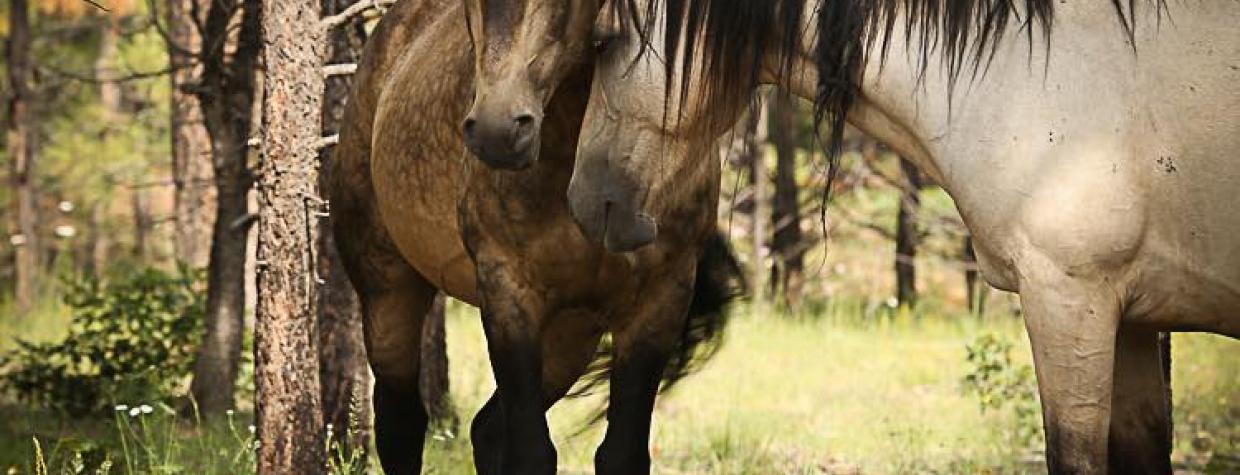A golden stallion with a dual-shaded mane watches approaching photographers with a cautious eye. He calmly moves between his company of four horses, most of which are smaller than him, and the eager photographers, who are clumsily stumbling over logs and rocks in a desperate effort to get a closer look.
Photographers from all over the country are drawn by the chance of capturing the serenity of a wild horse herd amid the green pines of the lush Black Mesa region of the Apache-Sitgreaves National Forests.
Here, the Heber wild horse herd is a natural attraction for locals and tourists alike. Some claim that the herd is a historical symbol of the area’s history, descendants of the mustangs that were brought to the area by Spanish explorers. But some view the herd as a complication and a nuisance. Many ranchers argue that the horses are overgrazing the area, which presents problems for their cattle.
Due to the continued conflict between wild horses and ranchers all over the country, the federal Wild Free-Roaming Horses and Burros Act was passed in 1971 to protect the animals from potential roundup and slaughter. However, the U.S. Forest Service argues that the current Heber herd is likely made up of of mostly abandoned horses without bloodline ties to the original herd.
The Apache-Sitgreaves National Forests spoke via email with Arizona Highways regarding a proposed management plan for the horses and how the public can provide input.
Can you provide an update for the proposed Heber horse herd management plan for 2016?
The ASNF is currently looking at developing a path forward that incorporates a collaborative process concept for developing a proposed action for the Heber Wild Horse Territory Management Plan. We’re anticipating rolling this out later this summer with the expectation of having a proposed action developed by the end of 2017. Public scoping of the proposed action is expected to occur in 2018 followed by the environmental analysis and development of a management plan for the Heber Wild Horse Territory, which is anticipated to be completed by 2020-2021.
If the horse numbers will be reduced, are you considering an adoption plan, and if so, how will this be made known to the public? Will sanctuaries be involved?
It would be premature to answer these questions at this time as no proposed action for the Territory Plan has been developed. The public will be informed and have various opportunities to provide input throughout the planning process.
What is the current population of the herd?
An aerial survey was completed in 2014. At that time there were 14 adults and 4 foals within the designated Territory, and another 184 horses observed on adjacent Forest Lands. Another aerial survey was completed in February 2015 and at that time there were 15 adults and 1 foal within the designated Territory, and another 201 horses observed on adjacent Forest Lands. The aerial surveys may not give the full answer as to population size but this is all the data that is available at this time.
Do the horses pose a risk to wildlife in the area?
Part of the analysis will be to look at all the uses occurring within the territory and determining the effects to all resource areas, including the horses. Effects of any proposed action on physical, biological, social, and economic environments within the planning area and the environmental consequences to those environments that may occur by implementing any action alternative will be part of the planning process.
Are birth control methods being considered, and if so, which ones?
It would be premature to answer these questions at this time as no proposed action for the Territory Plan has been developed.
How can the public provide input?
Public involvement and input will be encouraged throughout the planning process. The formal public comment period for the proposed action will begin when the Forest starts the public scoping of the proposed action. The public will also be invited to comment on the draft Environmental Impact Statement. Comments are reviewed and considered in the development of the Final EIS and Record of Decision.
Have DNA tests been done to determine the horses' bloodline?
The forest has not conducted DNA tests.
***
Robin Crawford lives in the Heber area and regularly photographs the horses. She spoke with Arizona Highways about what the animals mean to her and other locals.
What do the horses mean to you?
If you have ever seen the wild horses, whether a horse person or not, the sheer heart of the wild that you will sense is breathtaking. The Heber wild horses are true survivors, through countless brutal winters and long, hot summers. They are the last magnificent symbols of the West. And we will fight to keep them free, wild and unmanaged.
Do the horses bring a lot of tourists to the area?
In the last few years, as word has spread through social media, the Heber wild horses are drawing photographers from all over the world. Families that want to get out to camp and hike are asking where they might sight them. Our retirees can take their quads out on Forest Service roads in search of a sighting, and at times they'll be spotted along Forest Service roads. Like any wild animal, sighting them is not guaranteed. To ensure the future and freedom of the Heber wild horses, I would encourage everyone to come up and take some photographs of them. They live in one of the most beautiful national forests in Arizona. And go tell others of your experiences. Spread the word that the Heber wild horses are alive and well so far, with no interference from man. They’re an awesome sight to see!
— Isabel Menzel

